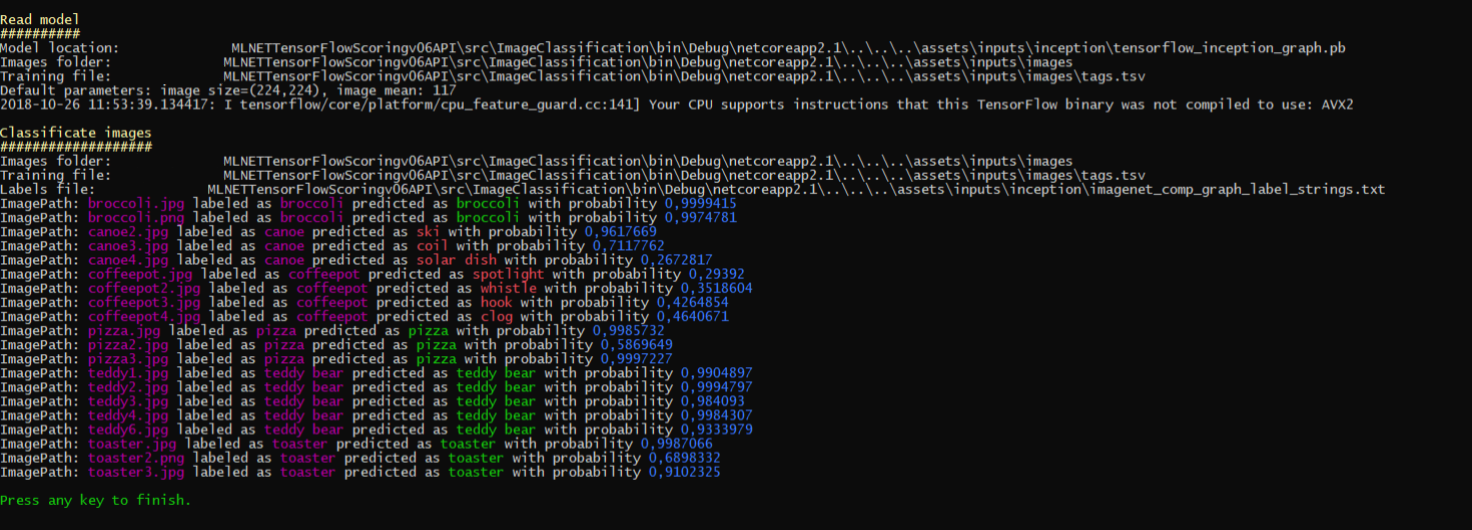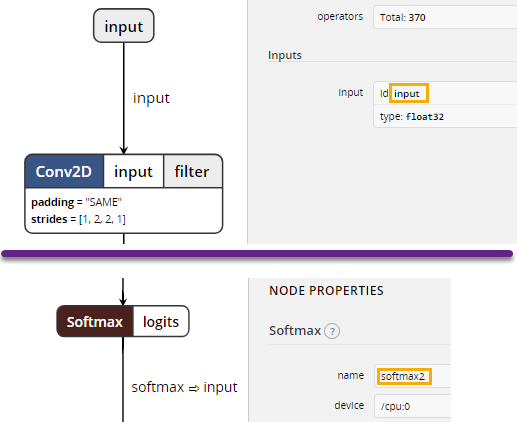写在前面
准备近期将微软的machinelearning-samples翻译成中文,水平有限,如有错漏,请大家多多指正。
如果有朋友对此感兴趣,可以加入我:https://github.com/feiyun0112/machinelearning-samples.zh-cn
图像分类 - 评分示例
问题
图像分类是许多业务场景中的常见情况。 对于这些情况,您可以使用预先训练的模型或训练自己的模型来对特定于自定义域的图像进行分类。
数据集
有两个数据源:tsv文件和图像文件。tsv 文件 包含2列:第一个定义为ImagePath,第二个定义为对应于图像的Label。正如你所看到的,文件没有标题行,看起来像这样:
broccoli.jpg broccoli
broccoli.png broccoli
canoe2.jpg canoe
canoe3.jpg canoe
canoe4.jpg canoe
coffeepot.jpg coffeepot
coffeepot2.jpg coffeepot
coffeepot3.jpg coffeepot
coffeepot4.jpg coffeepot
pizza.jpg pizza
pizza2.jpg pizza
pizza3.jpg pizza
teddy1.jpg teddy bear
teddy2.jpg teddy bear
teddy3.jpg teddy bear
teddy4.jpg teddy bear
teddy6.jpg teddy bear
toaster.jpg toaster
toaster2.png toaster
toaster3.jpg toaster
训练和测试图像位于assets文件夹中。这些图像属于维基共享资源。
维基共享资源, 免费媒体存储库。 于 10:48, October 17, 2018 检索自:
https://commons.wikimedia.org/wiki/Pizza
https://commons.wikimedia.org/wiki/Coffee_pot
https://commons.wikimedia.org/wiki/Toaster
https://commons.wikimedia.org/wiki/Category:Canoes
https://commons.wikimedia.org/wiki/Teddy_bear
预训练模型
有多个模型被预先训练用于图像分类。在本例中,我们将使用基于Inception拓扑的模型,并用来自Image.Net的图像进行训练。这个模型可以从 https://storage.googleapis.com/download.tensorflow.org/models/inception5h.zip 下载, 也可以在 / src / ImageClassification / assets /inputs / inception / tensorflow_inception_graph.pb 找到。
解决方案
控制台应用程序项目ImageClassification.Score可用于基于预先训练的Inception-v3 TensorFlow模型对样本图像进行分类。
再次注意,此示例仅使用预先训练的TensorFlow模型和ML.NET API。 因此,它不会训练任何ML.NET模型。 目前,在ML.NET中仅支持使用现有的TensorFlow训练模型进行评分/预测。
您需要按照以下步骤执行分类测试:
- 设置VS默认启动项目: 将
ImageClassification.Score设置为Visual Studio中的启动项目。 - 运行训练模型控制台应用程序: 在Visual Studio中按F5。 在执行结束时,输出将类似于此屏幕截图:

代码演练
解决方案中有一个名为ImageClassification.Score的项目,它负责以TensorFlow格式加载模型,然后对图像进行分类。
ML.NET:模型评分
TextLoader.CreateReader()用于定义将用于在ML.NET模型中加载图像的文本文件的模式。
var loader = new TextLoader(env,
new TextLoader.Arguments
{
Column = new[] {
new TextLoader.Column("ImagePath", DataKind.Text, 0)
}
});
var data = loader.Read(new MultiFileSource(dataLocation));
用于加载图像的图像文件有两列:第一列定义为ImagePath ,第二列是与图像对应的Label。
需要强调的是,在使用TensorFlow模型进行评分时,这里并没有真正使用标签。该文件仅作为测试预测时的参考,以便您可以将每个样本数据的实际标签与TensorFlow模型提供的预测标签进行比较。这就是为什么当使用上面的'TextLoader'加载文件时,您只需要获取ImagePath或文件的名称,但不需要获取标签。
broccoli.jpg broccoli
bucket.png bucket
canoe.jpg canoe
snail.jpg snail
teddy1.jpg teddy bear
正如您所看到的,文件没有标题行。
第二步是定义估计器流水线。通常,在处理深度神经网络时,必须使图像适应网络期望的格式。这就是为什么图像被调整大小然后被转换的原因(主要是,像素值在所有R、G、B通道上被标准化)。
var pipeline = new ImageLoaderEstimator(env, imagesFolder, ("ImagePath", "ImageReal"))
.Append(new ImageResizerEstimator(env, "ImageReal", "ImageReal", ImageNetSettings.imageHeight, ImageNetSettings.imageWidth))
.Append(new ImagePixelExtractorEstimator(env, new[] { new ImagePixelExtractorTransform.ColumnInfo("ImageReal", "input", interleave: ImageNetSettings.channelsLast, offset: ImageNetSettings.mean) }))
.Append(new TensorFlowEstimator(env, modelLocation, new[] { "input" }, new[] { "softmax2" }));
您还需要检查神经网络,并检查输入/输出节点的名称。为了检查模型,可以使用Netron,它会随Visual Studio Tools for AI一起安装。
这些名称稍后在评估器管道的定义中使用:在初始网络的情况下,输入张量被命名为“input”,输出被命名为“softmax2”。

最后,我们在拟合评估器管道之后提取预测函数。 预测函数接收类型为ImageNetData的对象(包含2个属性:ImagePath和Label)作为参数,然后返回类型为ImagePrediction的对象。
var modeld = pipeline.Fit(data);
var predictionFunction = modeld.MakePredictionFunction<ImageNetData, ImageNetPrediction>(env);
在获得预测时,我们得到属性PredictedLabels中的浮点数数组。数组中的每个位置都被分配给一个标签,例如,如果模型有5个不同的标签,那么数组长度将等于5。数组中的每个位置的值表示标签在该位置上的概率;所有数组值(概率)的总和等于1。然后,您需要选择最大值(概率)并检查指定给该位置的标签。
引用
训练和预测图像
维基共享资源, 免费媒体存储库。 于 10:48, October 17, 2018 检索自 https://commons.wikimedia.org/w/index.php?title=Main_Page&oldid=313158208.